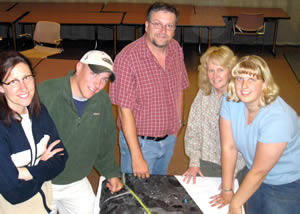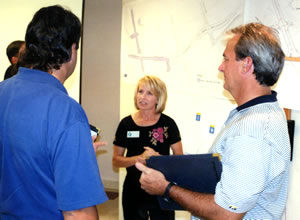 |
 |
|
 |
Windom crews help communities hit by fierce storm in I-90 corridor |
 |
 |
 |
| Maintenance workers
from the Luverne Truck Station begin to clear Hwy 75 of trees and other
debris after the storm. Supported by Arlyn Kiebach, Dean Luitjens and
Jerry Rigney, Roger Sorenson operates the loader. Photo by Randy Potts |
A storm packing 90 miles per hour wind gusts, hail and heavy rain caused extensive
damage along the I-90 corridor in southwestern Minnesota Aug. 4, sending Windom
Maintenance Area crews out to repair damage on state highways and help affected
communities with their recovery efforts.
The storm started as a squall in South Dakota, but gathered strength as it
moved eastward along the I-90 corridor.
Winds from the storm were strong enough to topple three 8 by 14 feet overhead
directional signs at two locations along I-90. The wind's force exerted enough
pressure on the signs to shear the bolts from their supporting posts and send
the signs crashing to the ground, said Tom Zimmerman, maintenance superintendent
at Windom. Two signs were destroyed at Worthington and one at Rushmore.
The winds also destroyed or damaged scores of smaller signs throughout the
area.
High winds blew a semi-trailer truck into the ditch on I-90 near Worthington,
causing it to jack-knife and block one westbound lane of the freeway. Traffic
was restricted for two hours until the wreckage was cleared. Crews also removed
a corncrib blown onto I-90 by the storm near Adrian.
After dealing with the most immediate problems, maintenance and bridge workers
from the Windom Maintenance Area fanned out to cities such as Luverne, Adrian,
Worthington and Lakefield to support their clean-up efforts.
In Adrian, for example, maintenance workers removed the twisted top of a grain
bin that had been hurled onto Hwy 91. In other locations, crews cleared streets
and roads of fallen trees and debris from damaged buildings to get them open
again, Zimmerman said.
When they returned to their shops, maintenance crews at Adrian, Luverne and
Worthington had more work to do-repairing their own storm-damaged shops and
yards.
Randy Potts, maintenance supervisor at Worthington, said the three shop locations
suffered uprooted trees, torn roof panels and damaged salt storage sheds.
Even then, the work wasn't over for the Windom area crewmembers. Most everyone,
Potts said, had fallen trees or other damage at their own homes and farms.
"I've got a lot of trees to pick up at my place," he said.
By Craig Wilkins
|
back

|
 |
Design-build reconstruction under way on I-494 |
 |
 |
 |
|
With the awarding of the $136 million contract for
reconstructing a 7.8-mile section of I-494, Mn/DOT begins another of its
12 highway projects scheduled for accelerated construction.
|
Another bond-accelerated project is under way with the award of the I-494 reconstruction
contract to Granite Construction of Watonsville, Calif., and C.S. McCrossan,
Inc., of Maple Grove.
The $136 million project adds an additional traffic lane in each direction
on a 7.8-mile section of I-494 between Hwy 5 in Eden Prairie and I-394 in Minnetonka.
The completion of this portion of the highway is part of Mn/DOT's overall effort
to make the Twin Cities metro area's outer beltway three or more lanes each
way.
"This stretch of highway is heavily used, carrying more than 90,000 vehicles
a day," said Kevin Anderson, I-494 project manager. "We anticipate
the work performed on the highway will greatly improve the flow of traffic for
motorists and represent the department's goal to build more and build faster."
The project was initially slated to start in 2007, but with the Legislature
granting Mn/DOT a $900 million transportation-funding package for its accelerated
construction program, this stretch of I-494 will be completed by July 2006.
"The previous schedule wouldn't have had this project completed until
around 2010," said Lt. Gov. Carol Molnau, transportation commissioner.
"But this project was one of our top priorities because we knew it was
a priority for the traveling public."
This portion of the I-494 project is one among 12 highway projects scheduled
for accelerated construction and the first to use Mn/DOT's new design-build
program that consists of a flexible contract template that sets out how Mn/DOT
expects to work with design-build contractors for projects of various size and
scope. Mn/DOT will customize the template to fit specific project needs.
"The idea to create this design-build template is another step in the right
direction for the department," said State Construction Engineer Gary Thompson,
director of the Office of Construction and Innovative Contracting. "Not
only will the design-build method speed up construction but completing the design-build
contract process using this template will also save time and potentially development
cost."
Minnesota is one of the first states to develop a contract-template program
for design-build, which is a construction project delivery method that overlaps
the design and construction phases so segments are designed and built simultaneously.
"We're glad the I-494 project was selected to use the new design-build
template, said Thompson. "I know everyone would agree that it's exciting
to see your work come off the pages and become a reality."
For more information about the I-494 reconstruction project or design-build,
visit the Web site at http://www.dot.state.mn.us/designbuild.
By Daneeka Marshall-Oquendo
|
back

|
 |
Hwy 14 project's accelerated schedule cause for celebration at Farmamerica event |
 |
 |
 |
|
Gov. Tim Pawlenty and Lt. Gov./Commissioner Carol Molnau
(in red and blue) pose with Mn/DOT employees from District 6 and District
7 at the Hwy 14 Janesville to Waseca "Acceleration Celebration"
at Farmamerica in Waseca on July 30. Photo by Wendy Meyer |
Gov. Tim Pawlenty and Lt. Gov./Commissioner Carol Molnau joined state and federal
legislators at Farmamerica on July 30 to celebrate that construction is under
way on the four-lane expansion of Hwy 14 from Janesville to Waseca.
The project, originally scheduled for construction years 2005 to 2009, was
advanced to 2004 through 2006, and is one of 12 large construction projects
in the state selected for acceleration under the 2003 Pawlenty-Molnau transportation
package.
Considerable progress has been made on Hwy 14 between New Ulm and Rochester,
but the only place dirt is being turned is on the four-lane expansion from Janesville
to Waseca.
The July 30 event, hosted by Waseca County and attended by more than 200 people,
included photo opportunities, remarks and refreshments. In addition, the lieutenant
governor, a farmer, drove a tractor that pulled a wagon of folks touring Farmamerica.
The contract for Hwy 14 (from Waseca County Road 60 on the west side of Janesville
to Waseca County Road 2 on the west edge of Waseca) was let in February 2004
to Mathiowetz Construction for $34.4 million. The project includes 10 miles
of grading, 12 miles of paving and three bridges. Construction was scheduled
to begin in May, but did not start until June 30 because of a delay in receiving
a permit from the U.S. Army Corps of Engineers.
By Rebecca Arndt, Mankato/District 7 public affairs coordinator
|
back

|
 |
Process links Mn/DOT with community leaders to minimize projects' effects on businesses |
 |
 |
 |
| Paul Jurek, project
manager, discusses how a new Hwy 23 frontage road may affect parking and
drive-through customers with Bonnie Franzen, co-owner of the Dairy Queen
store in Spicer. Photo by Sandy East |
- Each week, a newspaper reporter in Alexandria cranks out a column called
"The Word on 3rd." That's "3rd" as in Third Avenue in
the city, the route of Hwy 27 and Hwy 29 through town, and "word"
as in is how the reconstruction project will affect the city's residents,
businesses and tourists. The reporter receives regular updates from Jesse
Miller, project engineer; Judy Jacobs, District 4 public affairs coordinator,
and other district staff.
- Along the Hwy 23 corridor, now being reconstructed between Willmar and New
London, project manager Paul Jurek updates city leaders and business owners
weekly on the project's progress and ways they can cope with the changes it
brings.
- Every Monday, Bob Williams, the District 7 project manager for rebuilding
Hwy 14 in New Ulm, pulls up a chair with business leaders, city officials
and anyone else who has a question or concern about the project on Broadway
Avenue, the city's main thoroughfare.
- The Metro District uses approaches that range from lunches with business
leaders to a cable TV show to inform affected communities about the progress
of the $250 million Wakota Bridge project.
Each effort stems from Mn/DOT's adaptation of the Wisconsin DOT's "In
This Together" process that outlines how communities and project managers
can partner to minimize the inevitable impacts construction projects bring.
 |
| A sign beckons motorists
along Hwy 210 in Brainerd to patronize places along the road when it was
under reconstruction. Photo by Jenny Seelen |
ITT stresses communication, trust-building and novel approaches communities
may take to "thrive, not just survive" while projects are under way.
Mn/DOT first used ITT in 1999 when a part of Hwy 65 was rebuilt in Albert Lea.
Brian Jergenson, District 6 public affairs coordinator, decided to try the process.
"The key element in the success that we had was pitching ITT first to
the business community and the chamber of commerce," Jergenson said. "We
suggested business owners develop a plan, create partnerships and tell us what
would work for them."
The business community proposed signing and other ways to keep drivers aware
of how to reach their stores and provided feedback on the project's planning.
The chamber appointed a liaison with the project manager to keep communication
constant about the project's progress and community impacts.
Since its first use by Mn/DOT, the ITT process has been modified several times
to fit specific needs.
Metro's Wakota Bridge project also gets regular scrutiny from residents of
Newport, Cottage Grove, St. Paul Park and other cities in the I-694/Hwy 61 corridors.
Each week, project staff have lunch with members of the Newport-St. Paul Park
Chamber of Commerce to hear their concerns and find ways to address them.
Mary McFarland, a Metro public affairs coordinator, said the district conducts
a monthly public meeting and does a quarterly cable TV show to keep the communities
informed about the project's progress.
McFarland added she and project staff also stress the benefits the project
will bring when completed in 2006.
"For example, Hwy 61 now cuts Newport in half," she said. "When
the project's done, overpasses will improve road access to retail businesses
and industries and provide trails to make travel safer and easier for bikers
and pedestrians."
 |
| Kimberly Sannes, project
manager (at left), meets with members of the Hwy 1 design team (from left):
Jeff Madill, Larry Musholf, Cindy Lillegaard and Katie Johnson. Photo
by John Cavanaugh |
In a very different environment, Kimberly Sannes, a District 1 project manager,
is using ITT to plan rebuilding a 15-mile section of scenic Hwy 1 in Lake County.
In this instance, Sannes isn't dealing with business owners in one location;
instead, she's working with communities of interest that have strong opinions
about the project.
Sannes is drawing on her previous experience with the process that the district
employed during the reconstruction of Hwy 2 in Proctor. That project, she said,
underscores the value of working with communities long before construction work
actually begins.
Plans call for taming some of Hwy 1 many curves, widening the driving lanes
to 12 feet and adding six-feet-wide shoulders. The road currently lacks shoulders.
The groups include loggers who would prefer the road's curves be straightened,
environmentalists who would like the district to leave the highway as it is
and resort and cabin owners whose preferences fall somewhere between.
"While this isn't the typical ITT application, knowing and respecting
the divergent viewpoints people have about the highway and their strong emotional
attachments to it help us design the project with those interests in mind,"
Sannes said.
Cathy Clark, public affairs director with District 3, used a version of ITT
when the district rebuilt heavily traveled Hwy 210 that runs through heart of
Brainerd and Baxter last year.
"The process allows us to set a positive tone by communicating with chambers
of commerce and other business groups before the project begins," she said.
"We stress how the businesses can help themselves and help them realize
the value the project will create when its completed."
Clark, project manager Jamie Hukreide and other district staff enlisted the
support of business owners early on and used tactics ranging from a speakers
bureau to radio talk show appearances and a newsletter to keep the community
informed about the project.
 |
| Two representatives
of the Malt-O-Meal Co. in Northfield get a briefing from Rhonda Prestegard,
project manager, on plans to rebuild Hwy 3 near downtown Northfield. Photo
by Brian Jergenson |
"We suggested that the business owners pool their resources for advertising
and special promotions," she said, "and the district approved using
business logos on traffic signs to help customers and delivery drivers find
businesses with a minimal amount of trouble. We could make adjustments on the
fly because we knew who to talk with to get issues resolved."
The strong effort was needed, Clark said, because of the project's extent and
its effects on tourism in the region.
District 3 staff continue to use the ITT process on the widening of Hwy 371
and other projects.
This year, Jergenson's co-worker at Rochester, project manager Rhonda Prestegard,
took the process to Northfield. Rebuilding part of Hwy 3 in the city begins
this fall.
The project, she said, will require demolishing five businesses and relocating
eight more. The project's impacts are severe, especially in a small city such
as Northfield, but Prestegard said the changes to Hwy 3 will improve safety
in the area and add sidewalks, bike trails, wide boulevards and pedestrian crossings.
"We've already had numerous meetings with the community about the project,"
she said, "and we're staging it over two years to minimize its impact on
business access. This is never easy, but we hope the business community will
indeed 'thrive, not just survive,' until the project is completed."
By Craig Wilkins
New Ulm's newspaper lauds ITT use on Hwy 14 project
Rebuilding Hwy 14 (Broadway Avenue) through downtown New Ulm causes
its share of problems, but the Mankato District's efforts to lessen
its effects drew praise from the New Ulm Journal's "Thumbs Up/Down"
column.
The paper lauded the contractors and District 7 staff for their work.
"Much of the credit goes to the on-site crew headed by Mn/DOT
project engineer Bob Williams and chief inspector Marv Kruger. With
only a few minor missteps, their planning and preparations have really
minimized the inevitable inconvenience to residents trying to get from
one end of town to the other.
"Now, if the weather will cooperate, by fall we'll be driving
on new roadway out to 20th Street North which would make all residents
better able to cope with the construction from 20th Street west to the
airport that is yet to come next year."
|
|
back

|
 |
Lynn Eaton named as district engineer at Bemidji |
 |
 |
 |
|
Lynn Eaton |
Lynn Eaton, a veteran engineer and manager with Bemidji/District 2, was appointed
to succeed former District Engineer Wes Gjovik, who retired in July.
Eaton's appointment became effective Aug. 2.
Eaton began his Mn/DOT career in 1984 as a graduate engineer. Subsequently,
he served District 2 in staff and managerial positions in design, soils, project
management and district operations. Before accepting his new position, Eaton
was the district's project delivery engineer.
He also completed two mobility assignments as Road Research Section manager
with the Materials Office and another with the Office of Technical Service as
the state project management engineer.
Eaton holds a bachelor's degree in civil engineering from the University of
North Dakota; he also earned a master's degree in the management of technology
from the University of Minnesota.
Eaton may be reached at 218/755-3815.
Gjovik served with Mn/DOT for 35 years until his retirement. Before being named
district engineer at Bemidji in 2000, Gjovik was the assistant district engineer
for maintenance with Mankato/District 7.
|
back

|
 |
Hagerty will succeed Kordosky
as budget director |
 |
 |
 |
|
Hagerty and Kordosky prepare budget plans for the coming
biennium. Photo by David Gonzalez |
Michael Hagerty, a CPA with extensive experience in public sector finance,
will succeed Gordy Kordosky as Mn/DOT's budget director. His appointment was
announced July 29 by Scott Peterson, director, Office of Finance.
During the transition period until Kordosky's retirement later this year, Hagerty
will work with Office of Finance staff and managers on development of the fiscal
year 2006-07 biennial budget.
As budget director, Hagerty will provide leadership for developing and maintaining
the department's annual and biennial financial plans. He also will direct matching
budgetary requirements with Mn/DOT's strategic initiatives.
 |
| During his career
with Mn/DOT, Kordosky participated in a vanpool that transports employees
from White Bear Lake to St. Paul. He's logged about 250,000 miles as one
of the van's drivers. Photo by Craig Wilkins |
Before accepting his new position, Hagerty served in financial management with
the cities of Brooklyn Park and Minneapolis.
A St. Paul native, Hagerty holds a bachelor's degree in economics and accounting
from the University of St. Thomas. His telephone number is 651/284-0543.
Kordosky, who became budget director in 1979, will retire with 41 years of
state service with Mn/DOT and the Department of Revenue.
"Gordy provided many years of valuable service and has a vast amount of
knowledge about Mn/DOT and its operations," Peterson said. "We hired
Mike Hagerty to work with Gordy to acquire some of that knowledge in the months
before his well-deserved retirement."
|
back

|
 |
Dynamic merge system used to ease traffic through
construction zones |
 |
 |
Mn/DOT is using a new dynamic merge system in a construction zone on I-35 to
try to reduce back-ups, reduce crashes resulting from the back-ups, and relieve
some of the frustrations drivers experience when they encounter high traffic
volume work zones.
Microwave detectors, placed in advance of the lane closure, detect when traffic
speeds drop below 35 miles per hour. Variable message signs are then activated
to warn motorists of stopped traffic ahead and instruct drivers to stay in both
lanes. When motorists reach the merge location, they are instructed to take
turns merging.
Once traffic gets closer to the construction, motorists are allowed to begin
merging, causing less aggravated drivers and smoother traffic flow. This system
has been in place about two months. Crashes have been reduced, compared to a
similar project on I-35 two years ago. The State Patrol and others working on
this project have also seen a decrease in road rage.
Based on the reduced number of crashes and the positive feedback Mn/DOT has
received from the State Patrol, District 6 is pleased with the system so far.
The DMS system is also being used at several Metro locations this year.
Click here to read the entire July 2004 issue of the District
6 employee newsletter. You can access other districts' newsletters by clicking
on the appropriate link on Mn/DOT Newsline's navigation bar.
By Jeff Rieder, Rochester/District 6 Traffic
|
back

|
 |
National Park Service lauds state's documenting historic waysides for planning
needs |
 |
 |
 |
|
Completed in 1937, this rest area overlooks the St.
Croix River at Taylors Falls. It features stone construction including
its unique guardrails. The overlook is one of more than 100 owned by Mn/DOT. |
"Currents," the National Park Service's Web-based publication, features
Mn/DOT's research related to 102 state-owned historic roadside properties. The
properties include scenic overlooks, wayside rests and historical markers, most
of which were built during the 1930s and 1940s through New Deal federal relief
programs such as the Works Progress Administration. These programs were designed
to improve the nation's infrastructure and provide employment during the Great
Depression.
The publication favorably reviews the department's efforts to determine if
the properties are eligible for the National Register of Historic Places, identify
rehabilitation needs and estimated costs, and prepare a management plan that
will streamline design decisions. The plan also aids Mn/DOT when determining
maintenance needs, seeking rehabilitation funding or considering transferring
properties or partnership opportunities with other agencies. The research found
that 56 of the properties, plus one historic district, are eligible for the
national register.
The publication notes that researching the projects collectively instead of
individually reduced costs by about 40 percent. Because the research ranks the
properties according to historic significance and as part of a collection, Mn/DOT
will be able to better plan for and manage these cultural resources at a statewide
level. Each of these planning efforts is designed to save time and money and
help Mn/DOT invest wisely and on those properties deemed most historically significant.
As one of five pilot states nationwide that are demonstrating how transportation
needs can be balanced with environmental, cultural, community and aesthetic
concerns, Mn/DOT's context-sensitive research and planning efforts reinforce
its commitment to cultural resource stewardship, said Liz Walton, a landscape
architect with the Site Development Unit, Technical Support.
The paper can be viewed at
http://www2.cr.nps.gov/hli/currents/newdeal/introduction.htm.
By Craig Wilkins
|
back

|
 |
Department managers recognize Seeds students, program at annual event |
 |
 |
 |
|
Benard Obwocha, land surveying student at
St. Cloud State University, Office of Land Management, and Rassaki Radji,
a graduate student in economics, Maplewood Lab, introduce themselves at
the Seeds Day event July 29. Photo by David Gonzalez |
Mn/DOT welcomed 30 new students into the Seeds program at this year's Seeds
Day Recognition on July 29.
The event was held at the state Capitol and attended by about 120 employees,
including past and current Seeds students and their supervisors and mentors;
Lt. Gov./Commissioner Carol Molnau; and several division and office directors.
Molnau served as one of the guest speakers and presided over the awards and
recognition of Seeds graduates.
"Seeds is an innovative program that represents Mn/DOT's future,"
Molnau said. "These students are our next generation of workers and potentially
our future Mn/DOT leaders."
The program, which began in 1993, offers highly motivated students of color
or economically diverse students the chance to grow through on-the-job experience.
"Seeds is a valuable program here at Mn/DOT," said Emma Corrie, program
manager, Office of Workforce Development. "It emphasizes the importance
of introducing transportation-related careers to students while they are still
deciding which career path they would like to pursue."
More than 80 students have become permanent Mn/DOT employees working in a variety
of career fields across Mn/DOT offices and districts.
To qualify for the Seeds program, students must:
§ Enroll as a full-time student
§ Maintain a minimum GPA of 2.5 GPA (3.0 for engineering students)
§ Pursue a career needed at Mn/DOT
§ Provide a transcript at the end of each quarter or semester
§ Be a high school senior or older
Of the 38 current Seeds students, 14 are majoring in civil engineering. Other
majors include land surveying, architecture, finance and information technology.
The group represents students in high school as well as those pursuing master
degrees. More than half of the new Seeds students were acknowledged at the event
for maintaining a GPA of 3.5 or higher.
The rest of the day's activities included a guest speaker discussing leadership,
concurrent sessions about diversity and hiring practices. Seeds students organized
and coordinated the events of the day. Sheryl Cristobal, an accounting major
at the University of Minnesota's Carlson School of Management, and Gabe Gubash,
civil engineering student at the University of Minnesota, moderated the event.
By Daneeka Marshall-Oquendo
|
back

|
 |
Web server crash brings IT team to the rescue |
 |
 |
 |
Members of Mn/DOT's data and application infrastructure team moved
into high gear when Mn/DOT's Web server crashed. From left to right,
Lynn Verhaal, supervisor, Melanie Olson, Donna Karnuth, John Greco,
Vic Conocchioli, Jake Erickson, Mike Kangas, Leroy Larson, Robin Smith
and Ian Edhlund. Photo by David Gonzalez
|
Chances are you use the Web several times a week, but unless you are a Web
developer, you might not be aware of the hardware that makes it work…until
it fails.
Mn/DOT's Web server--aka "intravdev"--crashed on July 27.
It wasn't just a little crash, the sort of thing that could be fixed by a reboot;
the hard drive had failed and the machine needed to be completely rebuilt. It
was toast.
"The intradev server is the staging area that the majority of internal
and external Web pages flow through before they appear on iHUB or the main external
Web site. The server also includes space for development or testing areas,"
according to Jed Becher, Web coordinator, Office of Communications.
When intradev crashed late Tuesday afternoon, it meant that employees and customers
saw Mn/DOT internal and external Web pages as they looked just before the crash.
But employees could not post or edit pages. Mn/DOT's Web world was stuck in
cyber time.
Within minutes of being alerted to the problem, Mn/DOT's Data and Application
Infrastructure team, as well as other members of the Office of Information Technology,
moved into overdrive. After initial testing to determine that the machine was
indeed dead, a new server was procured and the team worked late into the night
to configure the new machine.
By Thursday morning the team was testing and tweaking and at 3 p.m. a note
went out giving Web developers the "all clear" signal that the server
was up and running again.
John Moreland, IT infrastructure manager, said that the unexpected crash gave
staff the opportunity to make several improvements to the server.
"We changed operating systems, installed a new statistics program and
a new search engine on the internal Web site," he said.
"The Web has come to be an absolutely critical tool to our customers and
our employees," said Bob McFarlin, assistant to the commissioner. "The
team of employees who dropped plans to be with family and friends and worked
late into the night truly rose to the occasion and saved the day."
By Kay Korsgaard
|
back

|
 |
|
 |



